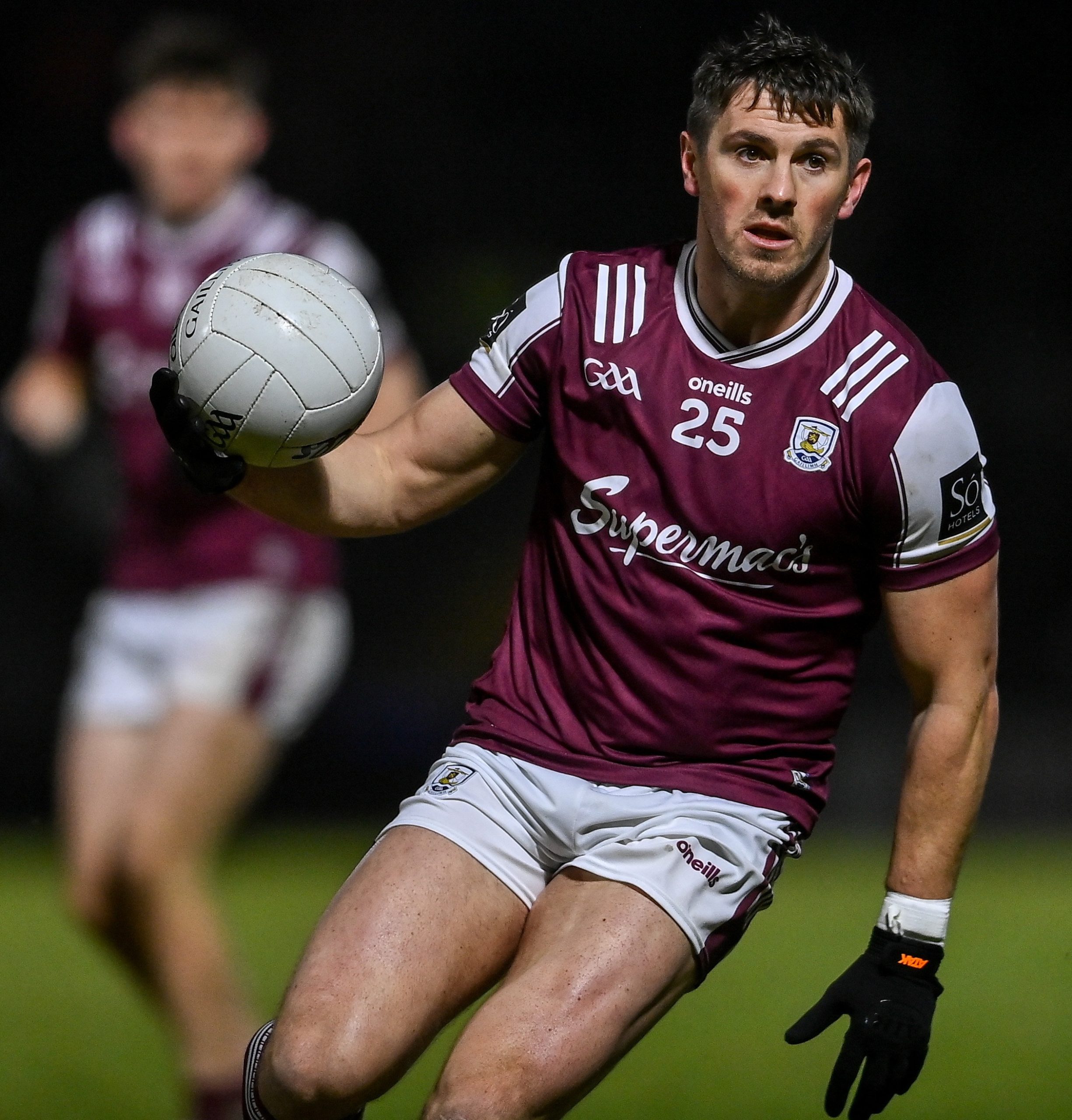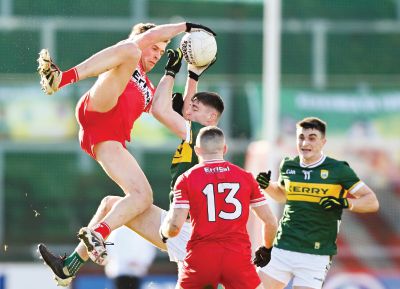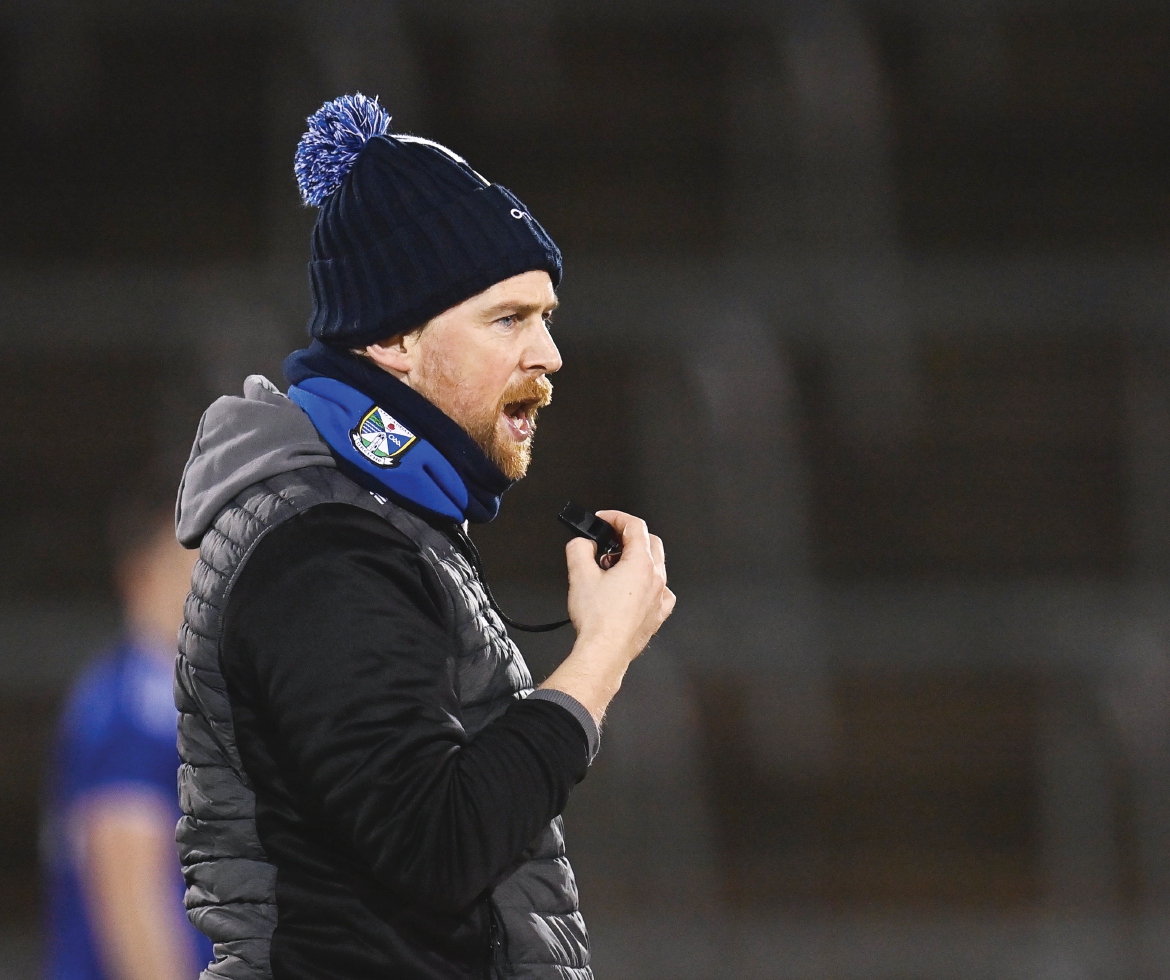Former Cavan forward and coach Seanie Johnston has taken a break from coaching this season but has been thinking about the FRC’s rule enhancements. He sat down with Michael McMullan…
IT’S a chilly night in Cavan. Seanie Johnston is inside, perched over a cuppa. Liverpool beanie on.
Watching their four-goal League Cup humbling of Spurs will engage him later.
A sporting fanatic. It hits you instantly. The Premiership title isn’t yet in the bag. A blip will give City or Arsenal a chance to pounce.
Moyes is getting a tune out of Everton. This week’s derby is a banana skin.
Johnston loves chatting about football. Klopp’s style was innovative and exciting. Slot is taken on the baton.
After a spell managing his native Cavan Gaels, Johnston is on a GAA sabbatical, yet the inner footballing lights are flashing.
The FRC’s new rule enhancements are everywhere. In this case, Johnston’s coaching brain ticks as he talks. A question. A pause. A thought. An answer.
He is excited without being fully sold. His mind is open. The new game excites him. You sense he’d love to get his teeth into making the enhancements work.
He agrees. They’ll tempt him back to coaching. Before that, we’ll start at the beginning. Was there a need for change?
“If you listen to enough negativity, everyone will start believing that we needed complete and utter change,” Johnston begins.
“I suppose, in reality, that’s what as happened here. If we look at it with a bit of theory and conciseness, change probably was needed.”
Multiple changes, all snowballing, brings some concern. Johnston isn’t a total cheerleader. There is too much of a thinker in him. But he’s open.
“Is there definite improvement over the last two weekends? Yeah, I think there is,” Johnston quickly adds.
Each of the enhancements need a deep dive. How much shape are they individually bringing? How many are linked? Do we need all seven?
“We probably need that little bit more time to have a look at the data,” Johnston offered.
“That was meant to come out after round two and they’ve pushed that back to get a little bit more feedback.
“After that, we’ll have probably a clearer idea of what’s making an improvement and what’s not.”
The perception of where the game is depends on the person. Fans want excitement across the board. And they want their team to win.
Inside a team bubble is different. Results rule. He can understand why the Armagh players weren’t raving after the inter-provincial games. They’d just won the All-Ireland. Hardly the position for championing change.
Johnston references Roscommon keeping possession for six minutes to take the sting out of Dublin at Croke Park two years ago.
“I think a lot of the fans’ images are coming from The Sunday Game, the media and the papers,” he said.
“That (Dublin v Roscommon) got jumped on and was the main topic of conversation for a significant period of time.”
These moments accelerate the need for change. And for it to be radical change.
Without the option of bringing the goalkeeper into the equation, in their own half, the new ruling will the offer a different game management approach, beyond the halfway line.
As Derry proved in Kerry’s ambush at Celtic Park, getting the ball across the halfway line brings the ‘keeper to the party. Late on, it would’ve given Derry and opportunity to breathe.
Johnston accepts the need clamping down on dissent and verbals. Moving the ball forward is “penal” but, in time, will be self-cleansing.
He approves of the solo and go. With it comes a “substantial” increase in speed, a key component in the FRC’s remit of making Gaelic Football exciting again.
The sight of Galway manipulating the one v one throw-in to get Shane Walsh on an early attack as Mayo dropped off isn’t lost on Johnston either.

LOOKING FORWARD…Seane Johnston feels the new version of Gaelic football has a significant focus on attacking players
Progressive. Exciting. An improvement on two men pulling and hauling to allow the other two to jump.
Johnston said one rule is spoken about more than the rest, a goalkeeper crossing the halfway line allows teams impose 12 men on 11.
“I think the kick-out, I’m interested to see where it goes,” Johnston adds.
“I think there are a lot of options to be innovative with it. There is nothing to stop a goalkeeper knocking the ball off the tee and dribbling out.
“I haven’t seen it in the games yet so that will be interesting to see.”
The other avenue for innovation is the new look press where a team actually sits off. Johnston thinks back to a passage from Derry and Kerry. This is where the gains are to be made. Graham O’Sullivan was left free on the sideline. Without the avenue of going back to the Shane Ryan, Derry could turn on a total squeeze.
And, with ‘keepers pushed up, it’s a press with 12 on 11.
“It was frantic for about 40-50 seconds,” he said. “Derry nearly got it and they didn’t get it and they nearly got it but Kerry got out and got a shot off.
“As teams get better at that, it’s basically a small-sided game where you have an extra player.”
This where coaching will evolve, possibly with a defender, perceived as the least comfortable on the ball, left free before being targeted.
While the FRC have unleashed plenty of new toys, you get an insight from Johnston as to how a coaching team will approach everything. In essence, this where excitement meets innovation.
There are still danger signs. How does the hooter work at club level? A referee on their own at a league game will be expected to police the three v three at the same time as working out where a player’s foot is planted in relation to the two-point arc.
There is also the question of fans actually knowing the rules. When Ethan Rafferty’s hand turned Andrew Murnin’s two-pointer into a one-pointer, some didn’t know why. At county level, there are eight sets of eyes looking on. Club is a one man operation.
“The three up, three back is a brilliant rule in terms of keeping more structure to the game,” said Johnston. He points to a proper structure and space to score.
“It’s all about how are we going to be able to manage this in all the local GAA fields around the country.”
He can’t see the hometown official putting up a flag as one of his own sets a foot on the wrong side of the line. This is the real challenge.
****
Derry 1-24 Kerry 5-15. And there could’ve been more goals. For an advocate of high scoring tallies, the enhancements are sweet music. What’s not to like.
Johnston starts calculating scoring averages. A part of the forwards’ union, is there part of the new game that’s unfair on defenders?
He comes back to numbers. 12 into 11 doesn’t go. The overlap tips the scales. There is also game awareness.
“If I’m a forward and know that I’m on one of the best corner backs or tacklers,” Johnston explains, “at different periods of the game, I would drag him out of that scoring zone.”
That leaves, 11 versus 10 without the best defender.
The conditions matter. He thinks Armagh against Tyrone, the wind and two-pointers. Sitting in versus pushing out, knowing where the sweet kicking spots are.
“There’s going to be a lot of tweaking over the next couple of weeks,” Johnston adds. “Until the best coaches nail it down.”
He refers to Ramor United having an absolute gale in the first half of the Cavan final, making two early subs and realising every score would be gold.
“You’re against the clock all the time,” he said of having the elements. “The clock is your friend when you’re playing the opposite way because you’re just trying to kill the game
“These news rules are obviously against killing the game as well. You really need your shooters, your long-range shooters on the field if you’re playing with that substantial wind at your back.”
It opens up the debate of impact men. A Stefan Campbell may be held in reserve as a boost for a score versus someone could be brought on to manage a game.
There is also the choice of using an Ethan Rafferty or a conventional goalkeeper. Like the decision on how to use your subs, it may come down to the strength of the wind.
There is also consideration of the opposition. Who needs marked and who can be left free. It’s hard to imagine Donegal not planning a tagger for Ethan Rafferty on Sunday. It will be the same for Derry with Shane Walsh.
“Teams now need to adapt,” Johnston said. “Teams will look at metrics and who is the least likely to score in these two-point zones.”
Away from the tactical side of the game, the rules enhancements will bring back some of the forgotten skills. The high catch. The breaking ball man is a big player again.
Johnston doesn’t fully accept it will change a focus with underage coaching. The skills should’ve always been the focus.
“To me it should be all about making our players better on the ball and to have a higher skill set, regardless of what the rules are,” he said.
“We talk about athleticism and this thing gets bandied about that you have be an athlete now.
“The Dublin team that won six All-Irelands in a row, they still had the best skill set of anybody in the country.
“They had a lot of stuff going for them and so on but they didn’t give you the ball back cheaply.
“I have three kids under five and if I’m coaching them out in the backyard, I’m still coaching them how to hand pass, kick the ball and do the basic skills really well. Then, you increase the speed they’re doing that in.”
Johnston expects “the majority” of the rule enhancements to stay. A big factor is what appears to be a political agenda. High-profile figures endorsing them will help the legs grow.
A narrative of the FRC being great and the perfection of their blueprint. The flip side of Roscommon’s six-minute possession sparking radical change.
Back to Johnston’s stance.
“I do think about the game a lot,” he sums up. “If you look at the rules as they are right now, managing the game is extremely difficult.
“In reality, speaking from a coach’s perspective, there is a skill to that. It’s a skill that you don’t want to see completely taken out of the game.”
Johnston looks back to the eighties, to the All-Ireland finals he grew up watching. Not exactly high-scoring classics.

MIDDLE GROUND…Seanie Johnston is interested in how a plan can be devised to get control of the ball from kick-outs
“It’s now becoming an extremely attack-focused game,” he outlines of the now.
“If that’s what people want to see, that’s brilliant but there’s also an art to defending and an art to controlling the game. I think you just have to find the balance between both.”
Can it happen, as the rules stand? “Nothing’s impossible,” Johnston says with a smile.
The secret is getting to halfway without having the ball squeezed into an attack going back at goal. Two years ago, Roscommon had a goalkeeper to engineer six-minutes of a second breath. Now, they’d have to get past the dashed line.
There is still an element of risk. A slip and it’s three v three. So, it’s not all that simple. It’s like teams pushing everyone up to the half way line to crowd the middle.
There is danger. A Shaun Patton arrow over the top, like on Saturday in Killarney. Just ask Derry about last summer’s horror shows.
“There’s been a lot of thought that’s gone into the FRC’s rules,” he sums up. “There’s a lot of really, really smart people. So, they have really looked at it.
“Is it a better product over the last two weeks? I think so. I’ve enjoyed it.
“I do think it is important that we take each rule as itself and look at it. I just wouldn’t pass judgement on it yet.
“I think we have to give it a little bit of time, then you’ll get a lot of the data back to suggest which ones are working well and which ones aren’t.”
He laughs at taking a year out of coaching yet spending an hour chatting rules and tactics over a cuppa. It’s impossible to escape rules’ chatter but he’s enjoyed it.
Finally, armed with the new enhancements, would Seanie Johnston be worried or excited about a coaching gig? He chooses the latter.
“There is a new challenge to it,” he sums up. “You have an opportunity, if you are innovative enough, to get a head start on people, particularly this year before people get all the different tricks of the trade.”
There is an excitement. Especially for the thinking coach.
“A lot more of your thought process is going to go into attacking play now rather than a lot of the stuff that has been defensive over a long number of years now. I think it is definitely exciting times for coaches.”
Did you know?
HERE are some queries that have arisen during the first two rounds of the NFL, in relation to the changes brought in my the FRC’s new rule enhancements.
When can a free be taken from outside the 40-metre arc for a two-point score?
The only time a player can opt to kick a two-pointer is if the ball is brought from outside the arc to inside. This is in the case of a free carried forward for dissent or an infraction of the 3v3 rule. Any free awarded inside the 40-metre arc cannot be moved outside.
A tale of two arcs
Under the previous rules, all players had to stand outside the small arc on kick-outs.
Now, a kick-out can be taken before all the players have moved out.
Forwards can intercept the ball, provided they are 13metres from the ball.
A defender only allowed to receive the ball outside the new 40-metre arc.
A defending player must be 13 metres – in a radius – from the ball despite not taking possession from the kick-out inside the 40-metre arc.
What happens if a team loses their goalkeeper?
A team must replace the goalkeeper with either putting a bib on an outfield player to take over as goalkeeper or introduce a sub-goalkeeper in. A team must always have an identifiable goalkeeper.
One point or two?
If the ball gets contact from another player, after being kicked from outside the large 40-metre arc, it’s only a one-pointer. A bounce off the post, bar or ground doesn’t count. A touch from another player – including a flick by the goalkeeper over the bar – counts as the final touch. Hence, it’s a one-pointer.
Beating the hooter
If a kick goes over the bar, kicked before the hooter sounds for the end of the game, it counts as a score.
If the ball touches any other player after the hooter, it’s deemed no score as the final touch came after the hooter.
If there has been an advantage played before the hooter sounds but no score ensues, the free can still be awarded after the hooter sounds.
Also, the advantage rule is no longer five seconds. It is not time specific, but it’s at the referee’s discretion.
Handing it on?
A player who commits a foul must hand the ball to the nearest player on the opposing team. The only exception is that if the goalkeeper is the person committing the foul. He may hand the ball to a teammate who will then hand it to the nearest opposing player.
Solo and go?
A team may not use the solo and go inside your attacking 20-metre zone.
Goalkeepers in their own half
Goalkeepers can only take a pass – kick, fist or palm – from a teammate, in their own half, if both are in the large rectangle when a ball is kicked into the square.
A player in possession of the ball is not permitted to run into the large rectangle and pass to the goalkeeper. Both players have to be in the square for the entire play.
There is a slight exception. If ball is kicked into a defence and deflects off a defender, the goalkeeper may take possession of the loose ball. The referee will make a judgement between a deflection and an actual palm back to the ‘keeper.
Have you a query about the rules? Get in touch – m.mcmullan@gaeliclife.com
Receive quality journalism wherever you are, on any device. Keep up to date from the comfort of your own home with a digital subscription.
Any time | Any place | Anywhere














